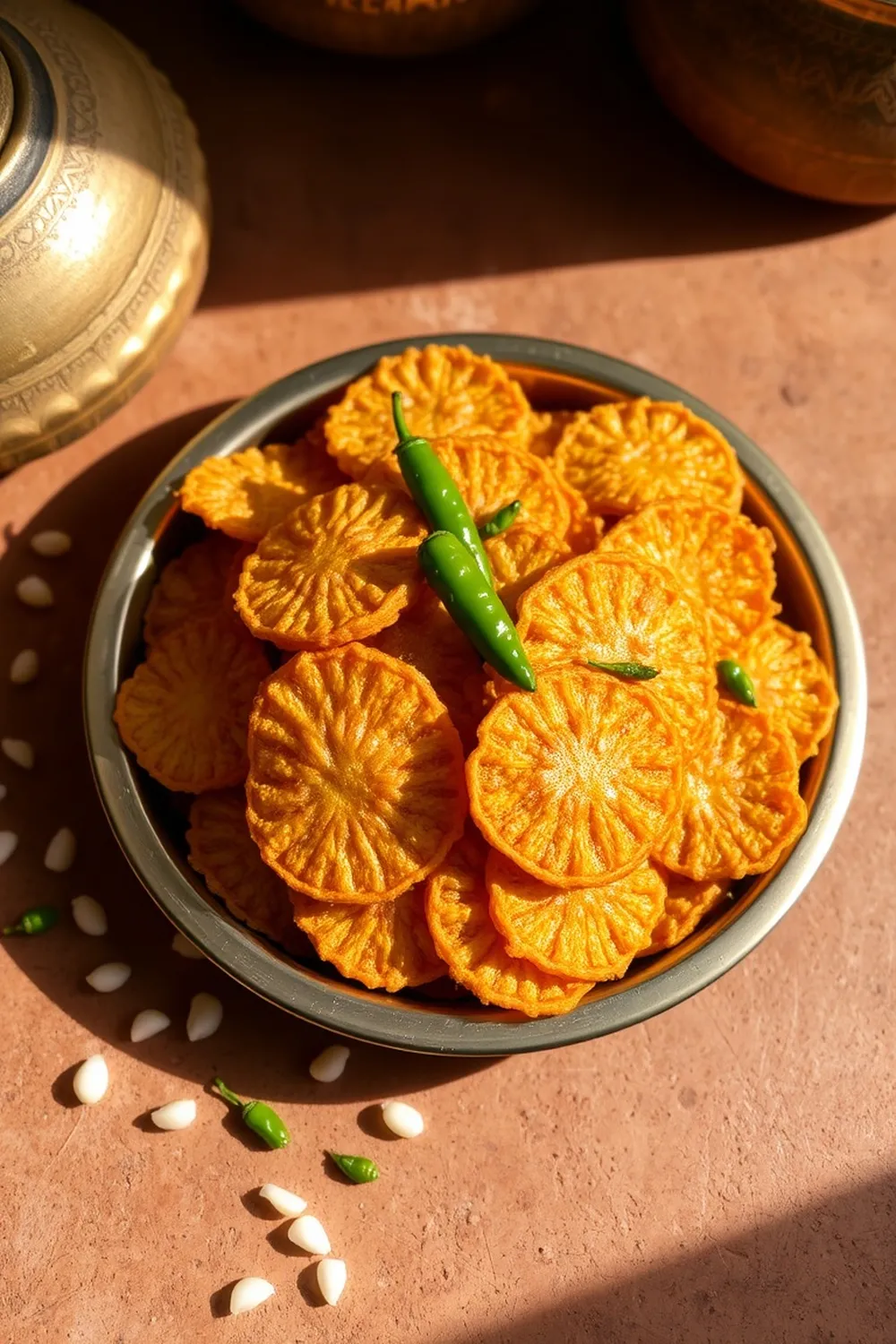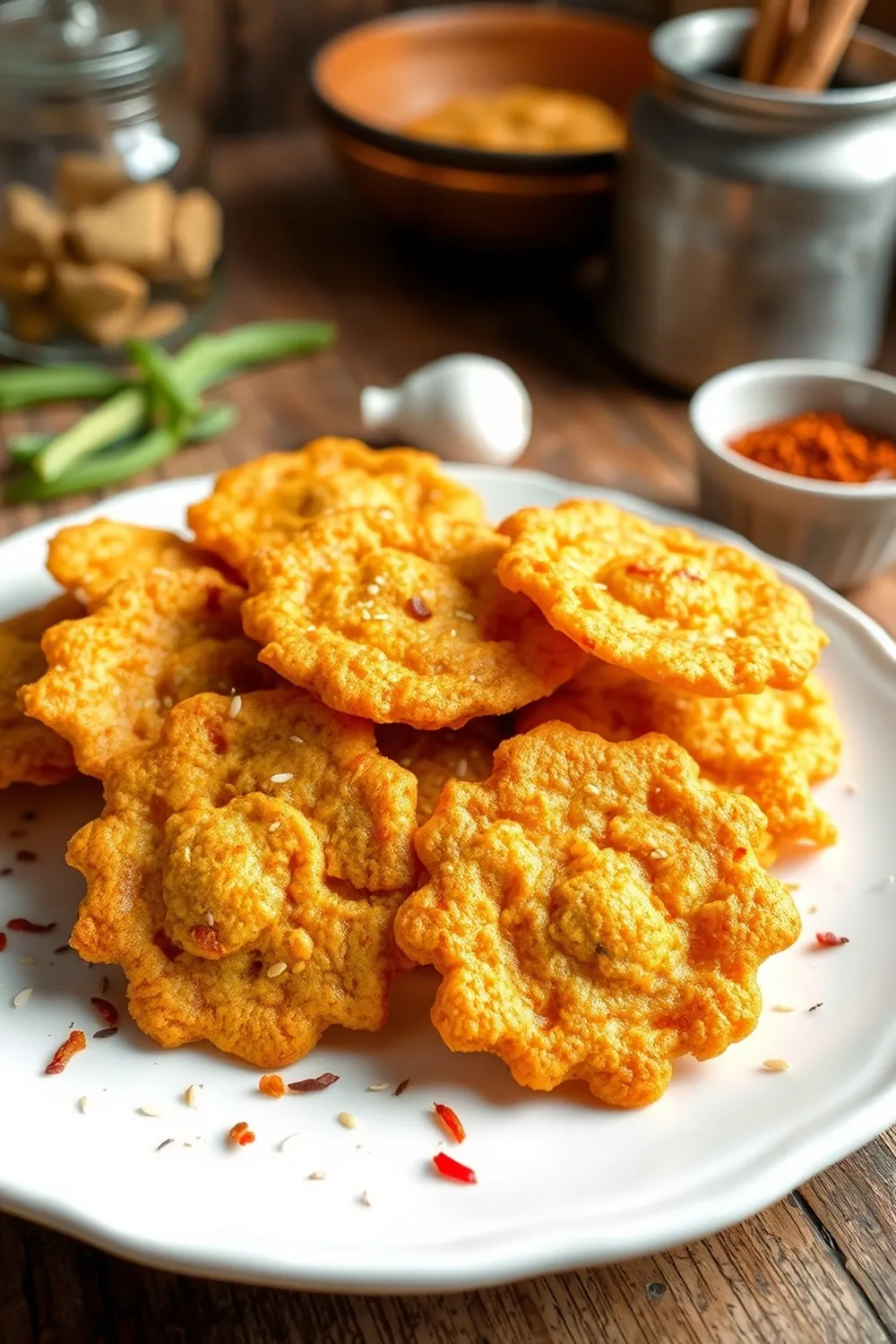- Soak raw rice and sago for 4-6 hours, then grind to a coarse paste with green chilies.
- Bring water to a boil in a pan and gradually add the rice mixture while stirring continuously.
- Cook on low heat until a thick porridge forms, adding cumin seeds and roasted cumin powder.
- Cool the mixture completely before pressing it through a star-shaped mold onto a clean, dry surface.
- Sun-dry for 3-5 days, flipping periodically, until completely moisture-free.
- Deep fry in hot oil until puffed and golden brown for a crispy texture.
- Store the dried vadams in an airtight container for long-term storage.
- Calories:106 kcal25%
- Energy:443 kJ22%
- Protein:2 g28%
- Carbohydrates:23 mg40%
- Sugar:1 mg8%
- Salt:70 g25%
- Fat:0.2 g20%
Last Updated on 4 months by Neha Deshmukh
Authentic Rice Vadagam Recipe – Crispy South Indian Snack
Hey everyone! If you grew up in South India, or have ever visited, you know the joy of a perfectly crispy vadagam with your evening chai. It’s that kind of snack that just instantly feels like home. I remember my grandmother making these during the summer months – the whole house would smell amazing! Today, I’m sharing my version of this classic recipe with you. It takes a little patience, but trust me, the results are SO worth it.
Why You’ll Love This Recipe
This rice vadagam recipe is all about that satisfying crunch and simple, authentic flavours. It’s a fantastic homemade snack that’s way better than anything you can buy in a store. Plus, making it yourself means you control the ingredients – no unwanted preservatives here! It’s perfect for a rainy day, a movie night, or just when you’re craving something savoury and delicious.
Ingredients
Here’s what you’ll need to make these crispy delights:
- 1 cup raw rice
- 1/4 cup sago (sabudana)
- 4 cups water (approximately 950ml)
- 3 green chillies
- 1 teaspoon jeera (cumin seeds)
- 1/4 teaspoon roasted jeera powder
- Salt to taste
Ingredient Notes
Let’s talk ingredients for a sec! Getting these right makes all the difference.
- Raw Rice: I prefer using a short-grain raw rice variety – it gives the vadagam a nice texture. Don’t use parboiled rice, it won’t work the same way.
- Sago (Sabudana): This is key for that light and airy crispness. Don’t skip it! It binds everything together and creates those little bubbles when fried.
- Cumin Seeds & Roasted Cumin Powder: Using both adds incredible depth of flavour. The whole cumin seeds give a fresh bite, while the roasted powder brings a warm, earthy note. Seriously, don’t skip the roasting step for the powder – it’s a game changer!
- Green Chillies: Adjust the number based on your spice preference. I like a good kick, but you can use fewer if you prefer a milder flavour.
Step-By-Step Instructions
Alright, let’s get cooking!
- First, soak the raw rice and sago together in 4 cups of water for at least 4 hours. Overnight is even better! This softens them up for grinding.
- Once soaked, drain the rice and sago. Add the green chillies and grind everything into a coarse paste. You don’t want it super smooth – a little texture is good.
- Now, in a wide pan, bring some water to a boil. Gradually add the rice mixture while stirring constantly. This prevents lumps from forming.
- Reduce the heat to low and keep stirring until it thickens into a porridge-like consistency. This takes about 10-15 minutes. Add the jeera and roasted jeera powder during the last few minutes of cooking. Don’t forget the salt!
- Remove from heat and let the mixture cool completely. This is important! Warm mixture won’t hold its shape.
- Once cooled, grease a clean surface (a plate or plastic sheet works well) lightly with oil. Press the mixture onto it using a star-shaped mould (or any shape you like!).
- Now comes the patience part: sun-drying! Place the vadagams in direct sunlight for 3-4 days, flipping them over periodically to ensure they dry evenly. They should be completely moisture-free.
- Finally, heat oil in a deep frying pan. Once hot, carefully drop in the vadagams and deep fry until they puff up and turn golden brown. This happens quickly, so keep a close eye!
- Remove with a slotted spoon and drain on paper towels.
Expert Tips
- Grinding is Key: Don’t over-grind the rice and sago. A coarse paste is what you’re after.
- Stir, Stir, Stir: Seriously, constant stirring while cooking is crucial to prevent sticking and lumps.
- Complete Drying: This is the most important step! If the vadagams aren’t completely dry, they’ll absorb too much oil and won’t get crispy.
- Oil Temperature: The oil needs to be hot enough, but not smoking. A medium-high heat works best.
Variations
Want to switch things up? Here are a few ideas:
- Vegan Adaptation: This recipe is naturally vegan!
- Gluten-Free Adaptation: It’s also naturally gluten-free.
- Spice Level: My friend Priya loves to add a pinch of red chilli powder for extra heat. Feel free to experiment!
- Regional Variations: In some parts of Tamil Nadu, people add a little bit of toor dal (split pigeon peas) to the mixture for a different flavour and texture. My aunt always adds a tablespoon or two!
Serving Suggestions
These are best enjoyed warm and crispy with a cup of chai or filter coffee. They also make a great accompaniment to sambar or rasam. Honestly, I just like to snack on them straight out of the jar!
Storage Instructions
Store the completely cooled and dried vadagams in an airtight container at room temperature. They should stay crispy for several weeks, if they last that long!
FAQs
1. What type of rice is best for making vadagam?
Short-grain raw rice works best. Avoid parboiled rice.
2. Can I skip the sun-drying process? What are the alternatives?
Sun-drying is ideal, but if you don’t have enough sunlight, you can use a dehydrator or even a very low oven (around 60°C/140°F) for several hours. Just make sure they are completely dry.
3. How do I know if the vadagam is completely dry before frying?
They should be hard to the touch and snap easily. If they feel even slightly soft, they need more drying time.
4. What oil is best for deep frying vadagam to achieve the perfect crispness?
Groundnut oil (peanut oil) is traditionally used and gives the best results. Sunflower oil or vegetable oil also work well.
5. My vadagam broke while frying. What could have gone wrong?
Most likely, the vadagams weren’t dry enough. They absorbed too much oil and became fragile. Make sure they are completely moisture-free before frying.










